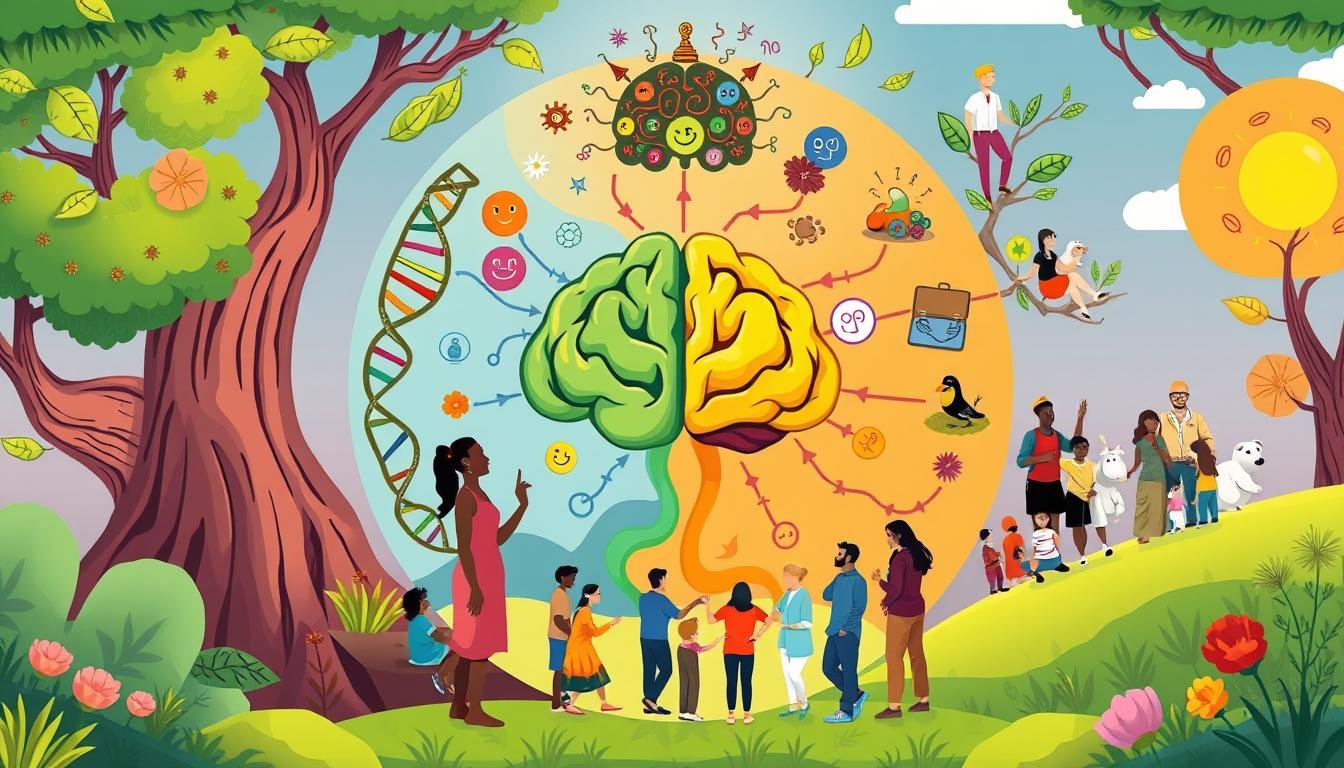Biopsychosocial Model: Holistic Health Approach
Have you ever wondered why two people with the same illness can have vastly different outcomes? The answer might lie in the biopsychosocial model. This approach to healthcare is changing how we think about health and wellness.
Developed in the 1970s by Dr. George Engel and Dr. John Romano, the biopsychosocial model offers a holistic approach to understanding health. It combines biological, psychological, and social factors. This creates a rich tapestry of integrated care that goes beyond traditional medicine.
This mind-body connection isn’t just theoretical. Studies show that social support can significantly reduce mental health issues compared to isolation. Physical activity positively influences mental wellness, while chronic pain can lead to symptoms of depression. These findings underscore the importance of considering all aspects of a person’s life when addressing health concerns.
The biopsychosocial model challenges us to look at health through a wider lens. It encourages healthcare providers to see patients as whole beings, not just a collection of symptoms. This shift in perspective could revolutionize how we approach healthcare. It could lead to more effective treatments and better patient outcomes.
Understanding the Biopsychosocial Model
The biopsychosocial model looks at health from many angles. It includes biological, psychological, and environmental factors. Introduced by George Engel in 1977, it changed healthcare by looking beyond just the body.
Origins and Development
Dr. Engel and Dr. John Romano created the biopsychosocial model in the 1970s. It was made to fix the biomedical model’s shortcomings. This new model aimed to understand health and illness in a more complete way.
Core Components: Biological, Psychological, and Social Factors
The model has three main parts:
- Biological factors: genetics, brain functions, and hormone levels
- Psychological factors: stress, thoughts, and how we cope
- Social factors: money, culture, and support from others
This model shows that mental and physical health are linked. For instance, genes affect mental health, but the environment also plays a role.
Contrasting with the Traditional Biomedical Model
The biopsychosocial model is different from the biomedical model. It looks at the whole picture, not just the body. This approach has led to better treatments and health outcomes.
| Model | Focus | Approach |
|---|---|---|
| Biomedical | Physical aspects | Treats specific symptoms |
| Biopsychosocial | Holistic view | Addresses multiple factors |
The Importance of a Holistic Approach in Healthcare
The biopsychosocial model, introduced by George Engel in the 1970s, changed healthcare. It looks at health from a whole-person view. This means health is shaped by biology, psychology, and social factors.
This model helps in treating mental health. It lets doctors tackle symptoms and the social and environmental causes. This way, they can find better, gentler ways to help patients.
Teams of different healthcare experts are key to this model. They work together to give patients care that covers all their needs. This makes sure patients get the best possible care.
“The biopsychosocial model allows us to see patients as complex human beings, not just a collection of symptoms,” says Dr. Sarah Johnson, a leading advocate for holistic healthcare.
Some say the model isn’t fully proven by science. But, it’s clear it helps patients a lot. Here’s what the model includes:
| Biological Factors | Psychological Factors | Social Factors |
|---|---|---|
| Genetics | Stress | Relationships |
| Physiology | Depression | Socioeconomic Status |
| Neurochemistry | Anxiety | Cultural Background |
By using this holistic approach, doctors can give better care. They focus on the whole person, not just symptoms. This makes care more effective and caring.
Biopsychosocial Model in Practice
The biopsychosocial model changes healthcare by mixing biology, psychology, and social factors. It makes patient care better in many medical places.
Application in Primary Care
Primary care doctors see patients with many health problems. The biopsychosocial model helps them tackle a wide range of issues. It’s very useful for symptoms that tests can’t find, like chronic fatigue or pain.
Benefits for Chronic Disease Management
Chronic diseases get better with the biopsychosocial model. It sees that long-term conditions affect the body, mind, and social life. This way of thinking leads to better management plans.
| Aspect | Traditional Model | Biopsychosocial Model |
|---|---|---|
| Focus | Physical symptoms | Whole person care |
| Treatment | Medical interventions | Interdisciplinary treatment |
| Outcome | Symptom relief | Improved overall well-being |
Enhancing Patient-Centered Care
The biopsychosocial model fits well with patient-centered care. It looks at the patient’s unique situation, likes, and social setting. This makes doctor-patient relationships stronger and helps patients stick to their treatment.
Even though it’s good, the model faces challenges in being used more. Time issues, lack of standard tools, and payment problems often stop it. But, as healthcare changes, more people see the value of integrated care and working together to help patients.
Challenges and Limitations of Implementing the Biopsychosocial Model
The biopsychosocial model faces many hurdles in the healthcare system. These issues affect how we deliver care and mental health services.
Time and Resource Constraints
Healthcare providers often have too little time and resources. This is especially true in primary care, where doctors see many patients quickly.
Lack of Standardized Assessment Tools
There are no uniform tools to assess patients with the biopsychosocial model. This makes it hard to evaluate patients the same way everywhere.
Resistance to Change in Medical Culture
Many healthcare places still follow traditional biomedical thinking. This makes it hard to adopt the biopsychosocial model and provide holistic care.
| Challenge | Impact on Healthcare | Potential Solution |
|---|---|---|
| Time Constraints | Rushed patient interactions | Restructure appointment schedules |
| Resource Limitations | Inadequate patient assessments | Increase funding for integrated care |
| Lack of Assessment Tools | Inconsistent patient evaluations | Develop standardized tools |
| Cultural Resistance | Slow adoption of new practices | Educate healthcare professionals |
To overcome these challenges, we need a team effort. Healthcare providers, policymakers, and institutions must focus on integrated care and mental health.
Conclusion
The biopsychosocial model, introduced by George Engel in 1977, has changed how we see health and illness. It looks at how our biology, psychology, and social life work together to affect our health. This way of thinking helps doctors give better care by understanding the mind-body connection.
Studies show that our early life, social surroundings, and choices affect our health a lot. The world is facing more non-infectious diseases and an aging population. This makes the need for a complete care approach even more urgent.
Even though using the biopsychosocial model is hard, its benefits are big. It can lead to better health results, save money, and focus on preventing problems. As we go on, using this model will be key to understanding and treating human health in a more complete way.
Source Links
- Understanding the Biopsychosocial Model
- Three Aspects of Health and Healing: The Biopsychosocial Model in Medicine
- The Biopsychosocial Model 25 Years Later: Principles, Practice, and Scientific Inquiry
- Best Biopsychosocial Model, Approach, Framework, and Factors
- No title found
- Understanding the Biopsychosocial Model: A Holistic Approach to Health
- Biopsychosocial Medicine: An integrated approach to understanding illness
- Biopsychosocial model of illnesses in primary care: A hermeneutic literature review
- Biopsychosocial model
- Biopsychosocial Model of Healthcare
- Limitations of the biopsychosocial model in psychiatry
- Embracing the Biopsychosocial Model in Healthcare: Challenges, Strategies, and Cultural…
- The Biopsychosocial Model 40 Years On – The Biopsychosocial Model of Health and Disease
- The BioPsychoSocial Model for Healing and Wellness by Your Marque Team








